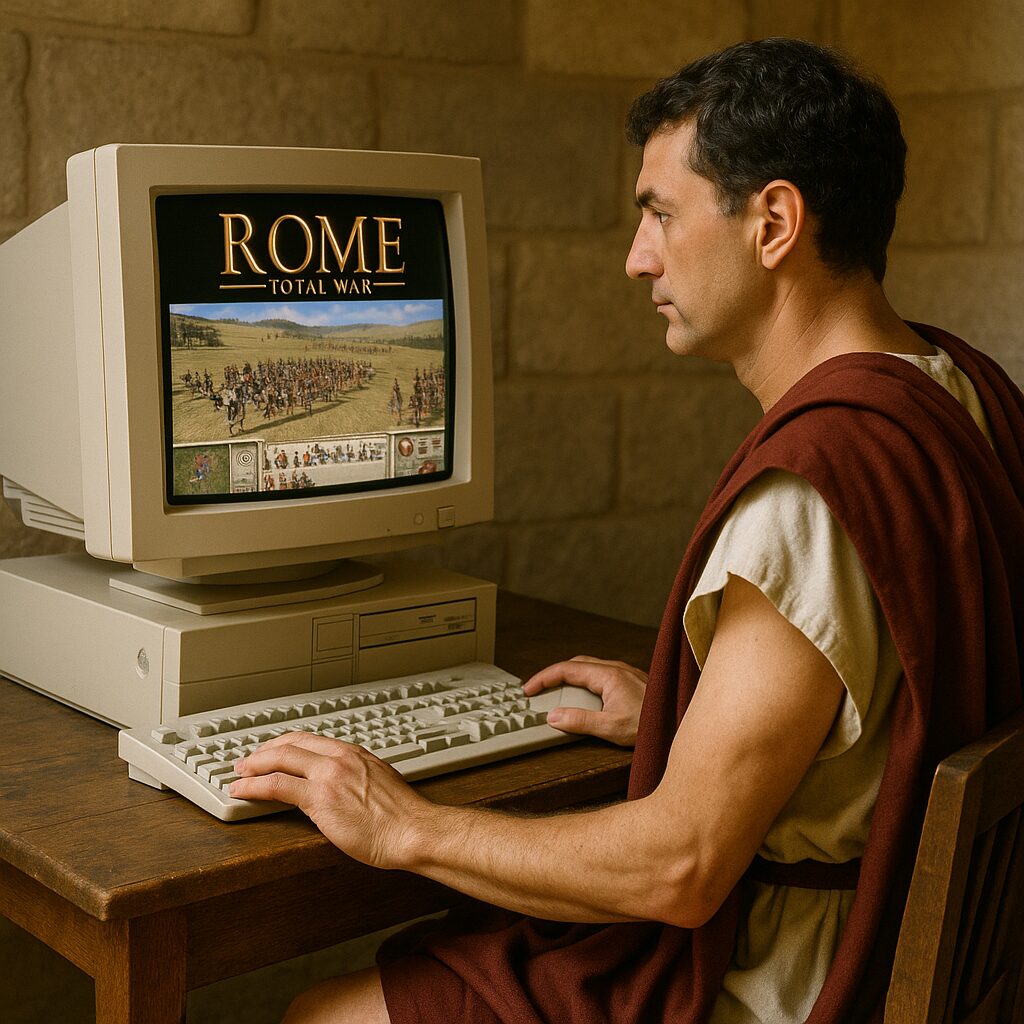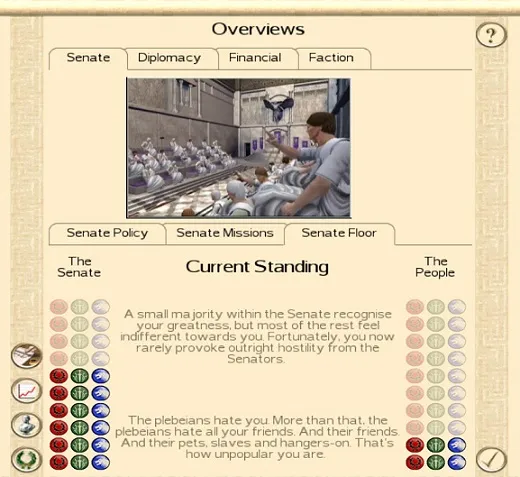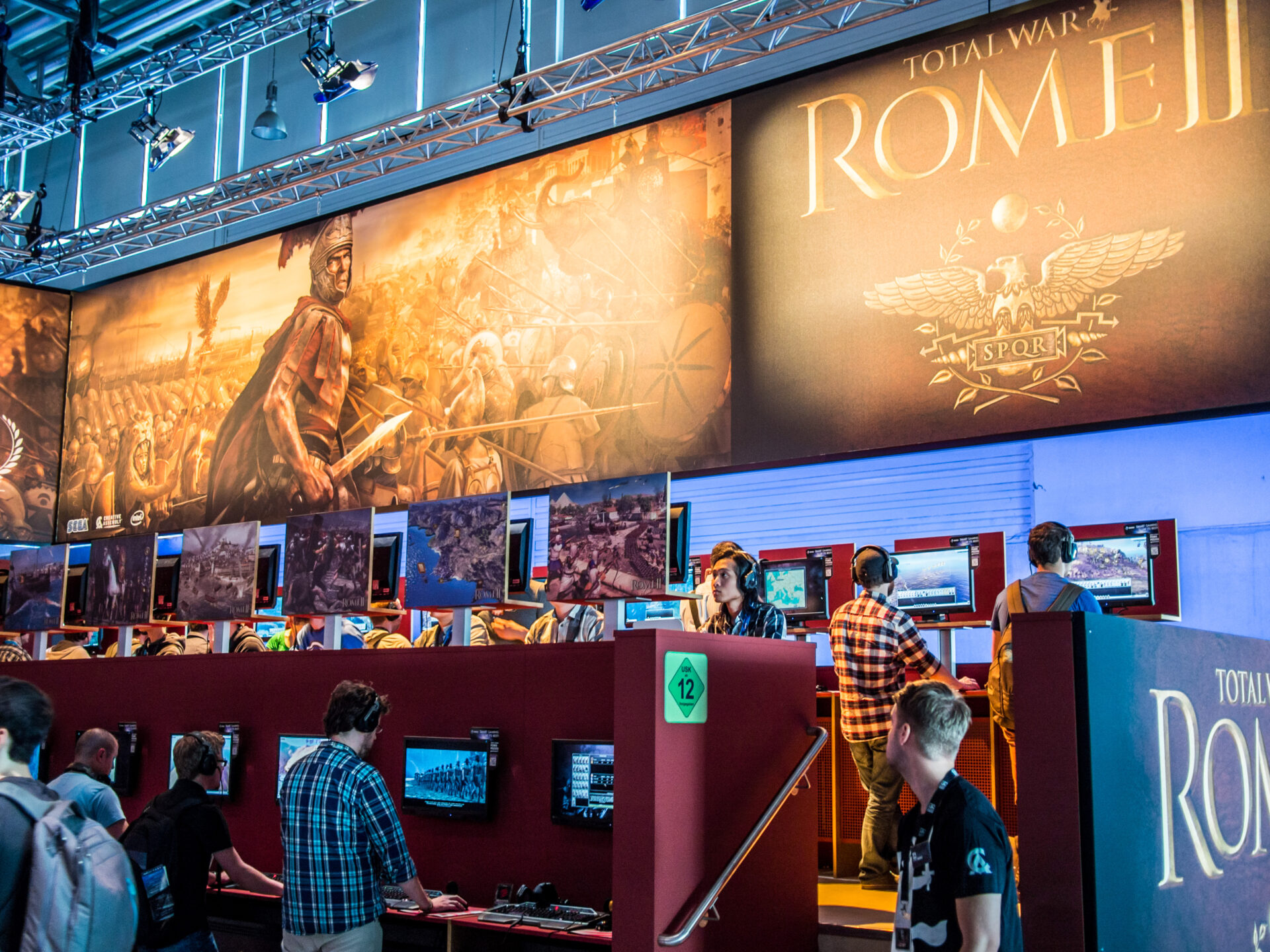For fans of ancient Rome, Rome: Total War wasn’t just a game — it was a portal to the past. Released in 2004 by Creative Assembly, this ambitious title became one of the most beloved strategy games of all time. It offered something few games had done before: the ability to control the fate of an empire from both the governor’s desk and the battlefield. Two decades later, Rome: Total War still remains a landmark title, not only in the Total War franchise but in gaming history.
This is the story of a game that let us march legions across the known world, sack Carthage, betray the Senate, and reforge the Roman Republic into our own vision of empire.

Rome: Total War (2004) – All Roads Lead to Glory
When Rome: Total War launched in 2004, I was 15 years old. In that time, I got my first PC since I live in, as they say, a developing country. This game changed my life. From that moment, I became a fan of history games, then a history buff, and now a historian.
For others, it marked a dramatic leap forward for the strategy genre. Combining a turn-based campaign map with epic real-time battles, it allowed players to manage empire-wide logistics and then zoom in to personally command thousands of soldiers on the field.
The campaign placed you at the head of one of three Roman noble houses: the Julii (north), Brutii (east), or Scipii (south). Each faction had unique starting positions and strategic priorities. Rome wasn’t just a goal — it was home. But eventually, you’d need to betray the Senate, conquer your rivals, and declare yourself Emperor.

Core mechanics included:
- Senate missions: Early-game political loyalty mattered. The Senate would reward or punish you based on how well you served Rome.
- Family trees and characters: Generals and governors had traits and retinues that influenced gameplay. A corrupt drunkard might ruin a city, while a disciplined commander could turn the tide of war.
- City management: From aqueducts and temples to barracks and forums, building a city meant balancing growth, happiness, and defense.
- Diplomacy: Alliances, threats, and trade deals gave depth to interactions with non-Roman factions — Gauls, Greeks, Egyptians, and more.
- Recruitment and movement: Every decision about where to place armies or build roads shaped the future of your conquests.
But the real magic happened in battle.
The real-time combat was a spectacle. Thousands of individual soldiers — each a tiny moving piece of your strategy — clashed in forests, deserts, and city streets. Terrain mattered. Morale broke units. Cavalry charges shattered flanks. It felt authentic, cinematic, and alive.
Then there was the atmosphere. Who could forget the voiceovers warning of Germanic hordes? The sound of marching feet echoing across the Alps? Or Jeff van Dyck’s unforgettable soundtrack — a fusion of classical tones with pulsing war rhythms?
Rome: Total War made you feel like a general, a politician, and a builder of civilization. It wasn’t just about domination — it was about legacy.
Barbarian Invasion (2005) – Rome in Crisis
The first major expansion, Barbarian Invasion, arrived in 2005 and fast-forwarded history to the 4th and 5th centuries AD — the beginning of the end for the Western Roman Empire.
This wasn’t the Rome of triumph. It was a Rome on the edge of collapse.
Players could now choose between the divided Roman Empires (Eastern and Western) or step into the fur-lined boots of invading barbarian factions like the Huns, Vandals, Goths, or Sassanid Persians. It was a radical change in tone: instead of expansion, the Romans were fighting for survival.
New mechanics gave the game a darker, grittier feel:
- Horde factions: Some barbarian tribes began the game with no settlements, moving as nomadic armies until they found a place to settle.
- Religion: Paganism, Christianity, and Zoroastrianism competed for influence, and conversion could lead to unrest or stability.
- Aging infrastructure: Roman cities were older, less efficient, and harder to control. Public order became a daily struggle.
Barbarian Invasion gave players a new kind of challenge — not to build, but to endure. For fans of Roman history, it was a hauntingly realistic depiction of decline, and it’s still praised today for its atmosphere and unique mechanics.
Rome: Total War Remastered (2021) – Return of the Emperor
Seventeen years after the original game’s release, Rome: Total War Remastered brought the classic back for a new generation.
Developed by Feral Interactive in collaboration with Creative Assembly, the remaster was a carefully crafted revival. It didn’t try to reinvent the wheel. Instead, it gave the old chariot a fresh coat of paint and smoother wheels.
Key improvements included:
- Visual overhaul: Units and terrain were rebuilt in higher resolution. The campaign map received clearer details and sharper textures.
- Modern UI and widescreen support: Navigating menus, cities, and armies felt faster and more intuitive.
- Better camera and controls: Zoom, rotate, and command with modern fluidity.
- Expanded content: All original factions were unlocked from the start, and both Barbarian Invasion and Alexander (if installed) were included.
- Modding and multiplayer: With improved support, mods became easier to install and share, while online play returned.
Still, the reception was mixed. While many players appreciated the faithful approach, others felt the remaster didn’t go far enough — it retained quirks of the old AI, some bugs, and an overall “dated” feel in places.
But the remaster succeeded in its mission: it gave Rome: Total War new life without compromising what made the original special. And for fans who grew up with the game, it was like returning to a childhood villa — familiar, dusty, and beautiful in its own way.
A Brief Note on Rome II: Total War
While this article focuses on the original Rome: Total War, it’s worth briefly mentioning Total War: Rome II (2013), the modern successor that attempted to carry the torch. Upon release, Rome II was met with mixed reactions due to bugs, AI issues, and performance problems.
However, over time and with numerous patches and DLCs, it evolved into a deeper, more complex grand strategy experience. It expanded the map, introduced more nuanced politics, and added intricate army traditions and faction mechanics. Yet, for many fans of the original, Rome II lacked the immediate charm and accessibility of its predecessor. It’s a technically superior game in many respects, but when it comes to atmosphere, clarity, and pure Roman immersion, the original still wears the laurel crown.

The Legacy of Rome: Total War
Few games have influenced their genre like Rome: Total War. Its innovations shaped the entire Total War franchise, from Medieval II to Shogun to Three Kingdoms. But it also left a mark on players, especially those with a love for ancient history.
Today, Rome: Total War continues to live on through:
- Modding communities, where total conversions like Europa Barbarorum, Roma Surrectum, and SPQR Total War transform the game into deeper, more historically grounded experiences.
- Educational use, with some history teachers using the game to visualize battles and geopolitics.
- Ongoing play, especially after the Remastered version made it more accessible to modern PCs and Macs.
It’s hard to find another game that taught so many players to pronounce “Julii” or understand Roman provincial politics.
In 2025, Rome: Total War still stands tall, not just as a classic, but as a playable, enjoyable game for both old fans and newcomers.
If you’ve never played it, you’re in for a treat. And if you have? Well, maybe it’s time to raise another legion, silence the Senate, and declare yourself Emperor once again.
Ave, player.
Hello, my name is Vladimir, and I am a part of the Roman-empire writing team.
I am a historian, and history is an integral part of my life.
To be honest, while I was in school, I didn’t like history so how did I end up studying it? Well, for that, I have to thank history-based strategy PC games. Thank you so much, Europa Universalis IV, and thank you, Medieval Total War.
Since games made me fall in love with history, I completed bachelor studies at Filozofski Fakultet Niš, a part of the University of Niš. My bachelor’s thesis was about Julis Caesar. Soon, I completed my master’s studies at the same university.
For years now, I have been working as a teacher in a local elementary school, but my passion for writing isn’t fulfilled, so I decided to pursue that ambition online. There were a few gigs, but most of them were not history-related.
Then I stumbled upon roman-empire.com, and now I am a part of something bigger. No, I am not a part of the ancient Roman Empire but of a creative writing team where I have the freedom to write about whatever I want. Yes, even about Star Wars. Stay tuned for that.
Anyway, I am better at writing about Rome than writing about me. But if you would like to contact me for any reason, you can do it at contact@roman-empire.net. Except for negative reviews, of course. 😀
Kind regards,
Vladimir
